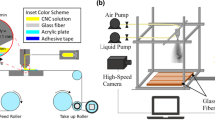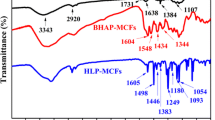Abstract
Automotive and aerospace industries require new lightweight materials that enhance payload and improve efficiency via vehicle weight reduction. Employing composites, such as fiber-reinforced polymers, is a common approach to reducing vehicle component weight. In this work, we examine the use of atomic layer deposition (ALD) to alter the interfacial chemistry in cellulose-reinforced epoxy composites. As produced, most cellulosics are hydrophilic and immiscible in industrially relevant hydrophobic polymers. In this study, a variety of ALD-derived surface modification schemes are explored to improve resin permeation within a fibrous, cellulose-based paper preform and to increase interfacial adhesion between the epoxy and the cellulose preform. Specifically, we consider surface modification of the cellulose paper with the ALD precursors trimethylaluminum (TMA) and titanium tetrachloride (TiCl4) with a water oxidant to form aluminum oxide and titanium oxide-based surface chemistries. Few cycle ALD treatments (2-cycles) combined with an additional post-deposition heating step are found to make the cellulose preforms more hydrophobic. X-ray photoelectron spectroscopy verifies the presence of the metal oxide surface treatments and points towards high concentration of adsorbed adventitious carbon as the source for surface hydrophobicity. Tensile testing of laminated epoxy composites made from these cellulosic preforms indicates two mechanical property regimes depending on surface treatment: (1) high toughness and high strain for preforms that underwent only an ALD coating and (2) high modulus and high strength for preforms ALD coated and then heated at 120 °C in air. ALD treatments resulted in an 80% increase in toughness and a 47% increase in strain at break. ALD treatments with post-deposition heating resulted in a 16% increase in the elastic modulus and a 27% increase in the ultimate tensile strength. Here we propose a combination of cellulose/epoxy mechanical interlocking and interfacial adhesion as mechanisms to explain the difference in mechanical properties of the explored composites.








Similar content being viewed by others
References
Asadi A, Miller M, Moon R, Kalaitzidou K (2016a) Improving the interfacial and mechanical properties of short glass fiber/epoxy composites by coating the glass fibers with cellulose nanocrystals. Express Polym Lett 10(7):587–597
Asadi A, Miller M, Sultana S, Moon RJ, Kalaitzidou K (2016b) Introducing cellulose nanocrystals in sheet molding compounds (SMC). Compos Part A Appl Sci 88:206–215
Asadi A, Miller M, Singh AV, Moon RJ, Kalaitzidou K (2017) Lightweight sheet molding compound (SMC) composites containing cellulose nanocrystals. Compos Struct 160:211–219
ASTM (2017) D685-17 Standard Practice for Conditional Paper and Paper Products for Testing. West Conshohocken, PA
ASTM (2018) D882-18 Standard Test Method for Tensile Properties of Thin Plastic Sheeting
Bae J, Samek IA, Stair PC, Snurr RQ (2019) Investigation of the hydrophobic nature of metal oxide surfaces created by atomic layer deposition. Langmuir 35(17):5762–5769
Barr TL, Seal S (1995) Nature of the use of adventitious carbon as a binding energy standard. J Vac Sci Technol A 13(3):1239–1246
Bartell FE, Cardwell PH (1942) Reproducible contact angles on reproducible metal surfaces contact angles of water against silver and gold. J Am Chem Soc 64(3):494–497
Belgacem MN, Czeremuszkin G, Sapieha S, Gandini A (1995) Surface characterization of cellulose fibres by XPS and inverse gas chromatography. Cellulose 2(3):145–157
Botaro VR, Gandini A (1998) Chemical modification of the surface of cellulosic fibres. 2. Introduction of alkenyl moieties via condensation reactions involving isocyanate functions. Cellulose 5(2):65–78
Carchini G, García-Melchor M, Łodziana Z, López N (2015) Understanding and tuning the intrinsic hydrophobicity of rare-earth oxides: a DFT + U study. ACS Appl Mater Interface 8(1):152–160
Chang AC, Chen S, Carter KR (2018) Cellulose nanocrystal surface modification via grafting-from sonogashira coupling of poly (ethynylene-fluorene). Cellulose 25(10):5731–5738
de Oliveira Taipina M, Ferrarezi MMF, Yoshida IVP, do Carmo Gonçalves M (2013) Surface modification of cotton nanocrystals with a silane agent. Cellulose 20(1):217–226
DiLoreto E, Haque E, Berman A, Moon RJ, Kalaitzidou K (2019) Freeze dried cellulose nanocrystal reinforced unsaturated polyester composites: challenges and potential. Cellulose 26(7):4391–4403
George SM (2010) Atomic layer deposition: an overview. Chem Rev 110(1):111–131
George J, Sreekala MS, Thomas S (2001) A review on interface modification and characterization of natural fiber reinforced plastic composites. Polym Eng Sci 41(9):1471–1485
Gomes AP, Mano JF, Queiroz JA, Gouveia IC (2013) Layer-by-layer deposition of antimicrobial polymers on cellulosic fibers: a new strategy to develop bioactive textiles. Polym Advan Technol 24(11):1005–1010
Goswami J, Haque E, Fox DM, Gilman JW, Holmes GA, Moon RJ, Kalaitzidou K (2019) The effect of cellulose nanocrystal coatings on the glass fiber-epoxy interphase. Materials 12(12):1951
Gregorczyk KE, Pickup DF, Sanz MG, Irakulis IA, Rogero C, Knez M (2014) Tuning the tensile strength of cellulose through vapor-phase metalation. Chem Mater 27(1):181–188
Gustafsson E, Larsson PA, Wågberg L (2012) Treatment of cellulose fibres with polyelectrolytes and wax colloids to create tailored highly hydrophobic fibrous networks. Colloids Surfaces A 414:415–421
Hashaikeh R, Krishnamachari P, Samad YA (2015) Nanomanifestations of cellulose: applications for biodegradable composites. In: Pandey JK, Takagi H, Nakagaito AN, Kim H-J (ed) Handbook of polymer nanocomposites. Processing, performance and application. Springer, New York, pp 229–248
Hyde K, Rusa M, Hinestroza J (2005) Layer-by-layer deposition of polyelectrolyte nanolayers on natural fibres: cotton. Nanotechnology 16(7):S422–S428
Hyde GK, Scarel G, Spagnola JC, Peng Q, Lee K, Gong B, Roberts KG, Roth KM, Hanson CA, Devine CK, Stewart SM, Hojo D, Na J, Jur JS, Parsons GN (2010) Atomic layer deposition and abrupt wetting transitions on nonwoven polypropylene and woven cotton fabrics. Langmuir 26(4):2550–2558
Johansson LS, Campbell J (2004) Reproducible XPS on biopolymers: cellulose studies. Surf Interface Anal 36(8):1018–1022
Kargarzadeh HM, Mariano D, Gopakumar IA, Thomas S, Dufresne A, Huang J, Lin N (2018) Advances in cellulose nanomaterials. Cellulose 25(4):2151–2189
Kim HC, Wallington TJ (2013) Life-cycle energy and greenhouse gas emission benefits of lightweighting in automobiles: review and harmonization. Environ Sci Technol 47(12):6089–6097
Lee K, Jur JS, Kim DH, Parsons GN (2012) Mechanisms for hydrophilic/hydrophobic wetting transitions on cellulose cotton fibers coated using Al2O3 atomic layer deposition. J Vac Sci Technol A 30(1):01A163
Lee KY, Aitomäki Y, Berglund LA, Oksman K, Bismarck A (2014) On the use of nanocellulose as reinforcement in polymer matrix composites. Compos Sci Technol 105:15–27
Li H, Peng L (2015) Antimicrobial and antioxidant surface modification of cellulose fibers using layer-by-layer deposition of chitosan and lignosulfonates. Carbohydr Polym 124:35–42
Li Y, Chen L, Wooding JP, Zhang F, Lively R, Ramprasad R, Losego MD (2020) Controlling wettability, wet strength, and fluid transport selectivity of nanopaper with atomic layer deposited (ALD) sub-nanometer metal oxide coatings. Nanoscale Advan 2:356–367
Mangolini F, McClimon JB, Rose F, Carpick RW (2014) Accounting for nanometer-thick adventitious carbon contamination in X-ray absorption spectra of carbon-based materials. Anal Chem 86(24):12258–12265
Miao C, Hamad WY (2013) Cellulose reinforced polymer composites and nanocomposites: a critical review. Cellulose 20(5):2221–2262
Missoum K, Belgacem MN, Bras J (2013) Nanofibrillated cellulose surface modification: a review. Materials 6(5):1745–1766
Moon RJ, Martini A, Nairn J, Simonsen J, Youngblood J (2011) Cellulose nanomaterials review: structure, properties and nanocomposites. Chem Soc Rev 40(7):3941–3994
Mulyadi A, Deng Y (2016) Surface modification of cellulose nanofibrils by maleated styrene block copolymer and their composite reinforcement application. Cellulose 23(1):519–528
Niemelä JP, Marin G, Karppinen M (2017) Titanium dioxide thin films by atomic layer deposition: a review. Semicond Sci Tech 32(9):093005
Piercy BD, Losego MD (2015) Tree-based control software for multilevel sequencing in thin film deposition applications. J Vac Sci Technol B 33(4):043201
Preston DJ, Miljkovic N, Sack J, Enright R, Queeney J, Wang EN (2014) Effect of hydrocarbon adsorption on the wettability of rare earth oxide ceramics. Appl Phys Lett 105(1):011601
Raymond MJ, Slater CS, Savelski MJ (2010) LCA approach to the analysis of solvent waste issues in the pharmaceutical industry. Green Chem 12(10):1826–1834
Roy D, Semsarilar M, Guthrie JT, Perrier S (2009) Cellulose modification by polymer grafting: a review. Chem Soc Rev 38(7):2046–2064
Seavey KC, Glasser WG (2001) Continuous cellulose fiber-reinforced cellulose ester composites. II. Fiber surface modification and consolidation conditions. Cellulose 8(2):161–169
Short AE, Pamidi SV, Bloomberg ZE, Li Y, Losego MD (2019) Atomic layer deposition (ALD) of subnanometer inorganic layers on natural cotton to enhance oil sorption performance in marine environments. J Mater Res 34(4):563–570
Siró I, Plackett D (2010) Microfibrillated cellulose and new nanocomposite materials: a review. Cellulose 17(3):459–494
Swift P (1982) Adventitious carbon—the panacea for energy referencing? Surf Interface Anal 4(2):47–51
TAPPI (2009) Water absorbency of bibulous papers. T432
Trejo-O’reilly JA, Cavaille JY, Gandini A (1997) The surface chemical modification of cellulosic fibres in view of their use in composite materials. Cellulose 4(4):305–320
Zhao Y, Tang Y, Wang X, Lin T (2010) Superhydrophobic cotton fabric fabricated by electrostatic assembly of silica nanoparticles and its remarkable buoyancy. Appl Sur Sci 256(22):6736–6742
Acknowledgments
This project was partially supported by the Renewable Bioproducts Institute (RBI) at the Georgia Institute of Technology. Jamie P. Wooding acknowledges support from a National Science Foundation Graduate Research Fellowship Program (NSF GRFP) under Grant No. DGE-1650044. Yi Li acknowledges support from an RBI Graduate Student Fellowship. Any opinions, findings, and conclusions or recommendations expressed in this material are those of the authors and do not necessarily reflect the views of the National Science Foundation or RBI. Dr. Mark Losego acknowledges support from an Early-Career Research Fellowship from the Gulf Research Program of the National Academies of Sciences, Engineering, and Medicine (Grant # 2000009646). Part of this research was conducted in Georgia Tech’s Materials Innovation & Learning Laboratory (The MILL), a “make-and-measure” space committed to enabling undergraduate research in materials science. This work was also performed in part at the Georgia Tech Institute for Electronics and Nanotechnology, a member of the National Nanotechnology Coordinated Infrastructure, which is supported by the National Science Foundation (Grant ECCS-1542174). Finally, the authors would like to thank Dr. Meisha Shofner for use of her Instron and Dr. Prateek Verma for advice.
Author information
Authors and Affiliations
Corresponding author
Additional information
Publisher's Note
Springer Nature remains neutral with regard to jurisdictional claims in published maps and institutional affiliations.
Electronic supplementary material
Below is the link to the electronic supplementary material.
Rights and permissions
About this article
Cite this article
Wooding, J.P., Li, Y., Kalaitzidou, K. et al. Engineering the interfacial chemistry and mechanical properties of cellulose-reinforced epoxy composites using atomic layer deposition (ALD). Cellulose 27, 6275–6285 (2020). https://doi.org/10.1007/s10570-020-03188-5
Received:
Accepted:
Published:
Issue Date:
DOI: https://doi.org/10.1007/s10570-020-03188-5




